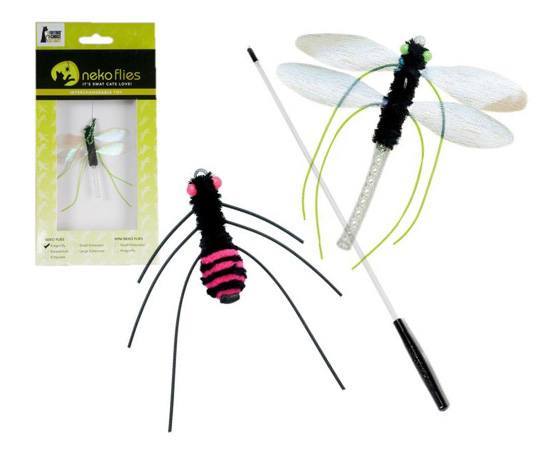Cat Allergies Don’t Have to be CATastrophic
Share

 Allergies can have a drastic impact on our health, including ear, nose and throat problems, upper respiratory issues and an overall drain of energy. As cat lovers, we want the best for our pets, but it needn’t come at the cost of our health. There are many ways to keep cats indoors and still reduce or eliminate allergies.
Allergies can have a drastic impact on our health, including ear, nose and throat problems, upper respiratory issues and an overall drain of energy. As cat lovers, we want the best for our pets, but it needn’t come at the cost of our health. There are many ways to keep cats indoors and still reduce or eliminate allergies.
If you’re allergic to your pet, rest assured that you’re not alone. Studies show that nearly two million Americans live with at least one cat in their home, despite being allergic.
According to Dr. Jorgenson of the Arizona Asthma and Allergy Institute, approximately 20% of the population suffers from allergies. The good news is that fewer than 10% of his patients choose the drastic option of re-homing their favorite felines, and if you love your cat, you already know why. Here are a few of the suggestions that he makes to help you live in harmony with your pets.
The Reasons Allergens Linger
Most cats exert a glycoprotein, which is simply a protein that has sugars attached to it, known as Fel d I. While glycoproteins are naturally occurring in all mammals, Fel d 1 is specific to our feline friends and is secreted through their sebaceous, or small skin) glands. Due to the unique chemical makeup of the protein, it can then easily attach itself to a cat’s dander. After grooming, the dander becomes airborne in the form of lightweight, microscopic particles, which then attach themselves to furniture, carpet, or particles of dust.
Removing Allergens at the Source
Even if a pet is no longer in the home, the allergen is difficult to eliminate and can take between 4-6 months (and a great deal of deep cleaning) before you’ll see a difference in particle levels. There are, however, many ways to share a home with your cats despite suffering from allergies. It all comes down to some minor home improvements that can even have the added benefit of increasing your home’s value.
- Replace Carpeting: Ridding your home of wall-to-wall carpeting is one of the best ways to alleviate allergies. According to Dr. Lori Coughlin, DVM and owner of The Cat Practice in Oak Park, Illinois, “Carpeting is the biggest culprit when it comes to trapping dust mites and spores.” Replace your carpet with tile, hardwood flooring, linoleum or even decorative concrete to dramatically reduce all types of allergens.
- Replace Curtains: Next to carpet, curtains are one of the biggest allergen attractants in your home. Consider replacing curtains with wooden or vinyl blinds. You’ll find them attractive and easy to clean, and custom blinds can actually increase your home’s value. If you do choose to stay with cloth curtains, be sure they are washable and made of synthetic fiber or plain cotton.
- Upgrade Furniture: Plush, soft furniture is a magnet for dust mites and pet hair, and can be difficult to clean. Try updating your cloth-covered furniture for a more modern look that is easy to maintain. Faux leather, vinyl and other similar materials won’t attract and trap allergens.
- Install a Central Vacuum System: Installing a central vacuuming system will help move the dander and dust outside of the home, rather than release allergens into the air. No more heavy portable unit to drag around the house, and it can actually increase the value of your home up to $2,000.
- Rid Home of Wallpaper: Get rid of that old wallpaper and create a new look with tile or paint. Oftentimes, the thick fibers of wallpaper can trap allergens and mold. When combined with water, this can lead to many types of allergies. Tiling your bathroom can dramatically increase your home value.
- Seal Up Doors and Windows: Your cat may not be solely responsible for your allergies! In areas with high levels of dust or mold, you may be allergic to something completely different. Ensure that your doors are completely sealed against the outdoors by using caulk and weather stripping, and consider installing double-paned windows. You will even be helping the environment (and your pocketbook) by reducing electricity and gas use.
- Filter the Air: You don’t need to pay for an entire new air conditioning unit. There are some very good systems out there that can help dramatically reduce or eliminate airborne allergens. Look into a central system that piggybacks your air conditioning / heating units, or you can invest in a portable HEPA (High Efficiency Particulate Air) filter.
- Create A “Cat-Free” Zone: Since we typically spend 1/3 of our time in the bedroom, creating a safe haven by keeping your bedroom a “cat-free zone” can be an alternative. According to Dr. Jorgensen, “Keeping the bedroom free of cats and adding a HEPA filter” can go a long way towards reducing allergies.
- Build an Outdoor Enclosure: Feline design is becoming the new trend in homes. By allowing your cat to spend part of the day in an air-conditioned (or heated) outdoor enclosure, you can create a little sanctuary for both you and your pets. Be sure to include lots of areas for climbing, toys to play with, and plenty of comfortable ledges for long naps.
- Grooming Outdoors: Brushing your cat’s coat each day can go a long ways towards reducing allergens, but be sure you take them into an enclosed, outdoor area before grooming. When you brush your pet in your home, you are simply releasing more allergens into the air. “Several of my patients have also found it useful to wipe their cats down with a damp rag each day,” says Dr. Coughlin. “Daily baths can dry the coat, resulting in over-grooming problems, and may needlessly stress your pet.” However, weekly baths have been demonstrated to eliminate nearly 84% of the allergens.
Living with cats and allergies can be done. With the new advent of immunotherapy, over-the-counter and holistic relief, portable HEPA filters and new technology, you can be successful in sharing your home with your cats. “All cats, even lions and tigers, produce the Fel d 1 allergen,” says Dr. Ronald Jorgensen. But some cats naturally produce less of it. The Cornish/Devon Rex, Sphynx and Siberian breeds are reported to create fewer reactions in those who have allergies.
If you or a family member has allergies, first ensure that it’s really your cats that you’re allergic too. Oftentimes, reactions are set off by other types of allergens. Use the methods mentioned in this article to reduce allergens throughout your home. And remember, when it comes to the levels of allergens, it depends on the individual cat. You may just discover that you have less of a reaction to one specific cat or cat breed than you would to another.











